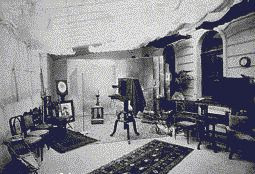
1.) DESCRIPTION5.10 - STRIPLIGHTS
Often the simple compartment floodlight is combined into multiple units connected together, forming a STRIPLIGHT. The striplight is one of the oldest stage lighting fixtures first having been developed for oil and candles and later for gas lighting. The striplight is also sometimes referred to a BATTEN or BORDER light as it often hung between the overhead masking borders.
With the introduction of the electric filament lamp it was possible to wire (or gang) a number of compartment floods together, forming a long linear fixture. The striplight has changed very little in the past 100 years. The typical unit of today is 4-9 feet long and is wired in 3 or 4 electrical circuits. By using alternating color filters (usually red, blue, green and sometimes amber) the striplight makes a very flexible color wash lighting fixture.
2.) APPLICATIONS
Permanent striplights are often found installed in older theatres, auditoriums and schools. Typically several units are used, running continuously from stage-left to stage-right. The 'strips' are usually installed downstage, centre stage and upstage. Through dimmer control, and using the 3 primary colors of light, the designer can mix almost any color. One moment the entire stage can be bathed in deep cold blue and the next it can be transformed into a warm golden amber. Overhead striplights as a general source of 3 color illumination are seldom used today, most designer preferring the more controlled use of the fresnel spotlight or even the PAR64, for wash, toning and blending applications. (p> Today, 3 or 4 circuit striplights are commonly used to light the top and bottom of backdrops and cycloramas (sky cloths).
FOOTLIGHTS are simply striplights placed on the floor, along the downstage edge of the stage. Once a principal source of stage lighting, footlights were also often wired to provide 3 or 4 color washes. Although seldom used today, footlights still can prove invaluable for certain lighting applications. Used sparingly, they can provide excellent low 'fill' light to a performer's face and can help eliminate shadows from overhead lighting, from hats, roofs, etc.
3.) TYPES
The modern STRIPLIGHT typically consist of a row of MR16, PAR, R (reflector) or double ended halogen lamps, mounted into a single compartmented fixture approximately 6-9 ft. long. The modern striplight is also wired in 3 (or 4) color circuits. Striplights are manufactured in various sizes, to use lamps with wattages of 75, 150, 300, 500 or 1000 watts each. Striplight fixtures commonly use glass or plastic colored filters in removable color frames. The modern striplight is used both in overhead and floor mounted applications (downlight and uplight)
TYPE BEAM SPREADS WATTAGE DESCRIPTION
=====================================================================
Striplights 70-100 fixed 75-1000 VERY SOFT edge
---------------------------------------------------------------------
INCLUDED: - (a) power cord (usually 3 or 4).
OPTIONS: - (a) lamps, (b) pipe clamps, (c) color frames, (d) safety cables, (e) electrical connectors, 3 or 4, (f) hanging hardware, (g) floor mounting hardware.















